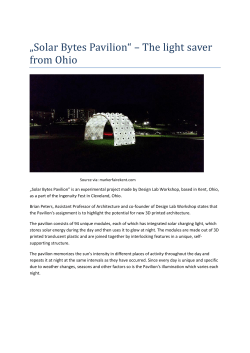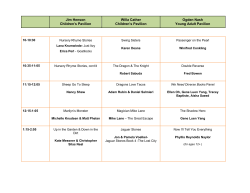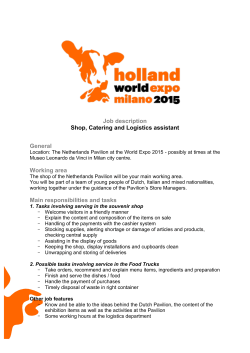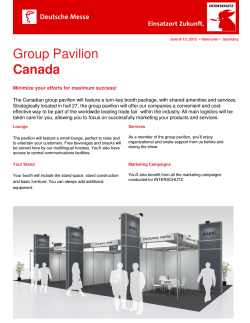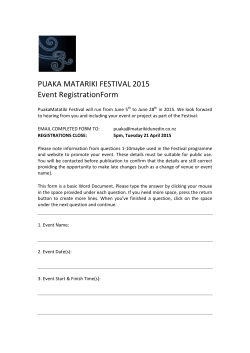
Danker 2014 `A Student Perspective on Self
AAE 2014 CONFERENCE PROCEEDINGS FRINGE FESTIVAL/MAGIC MOMENTS A Student Perspective on Self-Initiating Design-Build Fabian Danker Northumbria University Introduction A number of routes were explored to find a client including an international break dance choreographer; director of circuscompany; performance artist and director of a Latin Festival. The student and client had to match diary schedules for the year to be able to commit time to each other as well working to enable the project to benefit the community. A Masters of Architecture design thesis project developing a collaborative practice in architecture, art and sound. A pavilion is designed for the VAMOS! Festival to create an experiential micro-climate, in which lighting and sound installations reflect Latin American culture. During this period media-packs were sent out to a number of companies to gain materials or sponsorships. CAD and CNC technologies were also explored and developed to investigate current capabilities of construction. The concept of making a structural modular framework was developed. This would be a system of components which could create a number of forms, expandable, quick and easy to assemble and made of sustainable materials. The project began with nothing. Between October 2013 and June 2014 a client was found; the brief and design developed; sites and transportation procured; artists, musicians, engineers and other collaborations explored. Local businesses were approached and agreed sponsorship-in-kind of materials or to manufacture components. As the first design-build project undertaken at Northumbria University, it applies principles of collaboration, networking, management, law, logistics and feasibility to teaching and learning. By the end of semester 1, a meeting with the director of the Vamos Festival created a focus for the project. Identifying a need for a pavilion for the Vamos Festival created the brief which was divided into three parts. A small pavilion for the Vamos festival 2013, a 100 person pavilion using the principles from the small pavilion and a business enterprise creating temporary structures. Interested in the structural framework proposed, the director of the Vamos Festival wanted a document to illustrate the pavilion's principles to present to his funding partners in order to secure funding for a future pavilion. What's Your Problem? The traditional design project at Northumbria University Masters is divided into two parts; problem setting and problem solving. These two parts are derived through site investigation of environment, demographics, context, ecology, economy, religion, history and concept. During this stage, students create a large body of research which can then be refined to underpin current problems of the site. Through research of precedent studies, drawing, model making and iterative design, an architecture is developed and proposed to "fix" these identified problems. Learning Through Making Design-build projects allow students to develop an understanding of the link between drawing and making. Addressing the limitations and challenges which develop from making decisions and overcoming them is a large portion of Campus:Live. Student-initiated problem setting Materials Campus:Live is a pioneering design-build project at Northumbria University. The first semester was orientated around "problem-setting"; this would be developed in order to create an architecture from it. As the project was fully student-initiated, a client had to be found to create a starting point. Manufacturer of Sterling OSB, Norbord agreed to donate materials at an early stage in the project. Willmott Dixon agreed to donate plywood, plastic sheet covering, DPC, piping insulation. A local builders’ merchants, Max Fixings donated nuts, bolts and washers. BAM contributed towards the manufacturing costs. Grants were also procured through the RIBA. 259 AAE 2014 CONFERENCE PROCEEDINGS FRINGE FESTIVAL/MAGIC MOMENTS Facilities Structure Limitations in facilities able to create large-scale and mass production projects created further problems. It was identified by the start of Semester 2 that outsourcing the manufacturing process would be the only method of delivering a project in time for the Vamos festival in June. Building a 1:1 scale section of the pavilion identified 3 major problems with the design when made from OSB. 1) Slow to assemble. 2) Weak material when used in this method. 3) Structurally unsafe during and after assembly. Fig. 1. CNC cut component from plywood Fig. 3. 1:1 Scale section model Shed structural engineers agreed to collaborate on the project to ensure that the structure would be safe for public use. It became apparent that the project would branch in two directions after this point. The first part to deliver a pavilion for the Vamos Festival and the second to fulfil the structural framework developed previously without limitations of low budget and short time scale to deliver a full scale project. Fig. 2. Site to Decor Panel during manufacturing Decor Panel was the most suited to CNC manufacturing, with the majority of jobs based on mass production of kitchen cupboards. Legal advice, insurance and liabilities Journal Extract Legal advice was sought through one-off free legal service through Bell Hoare Bell Solicitors. Advice on public liability were discussed. Further advice was given by Locus+, an artist management group specialising in outdoor art performances who went into further details of hazards and liabilities. "Today I have experienced the lowest point within the project. When arriving at Decor Panel, I noticed that all the pieces had been cut wrongly. The emotional attachment to the project became apparent and can only be described as "stomach churning". After trying my hardest to maintain composure and calmly explaining the mistake to the technician, I had to run to the toilet to vomit. Arriving back to the studio, it took a few hours to regroup my thoughts and carry on working." As the pavilion would be exhibited on public and university property, liability had to be addressed. Sites on campus were carefully chosen to make sure that it would be available to public viewing, had CCTV surveillance, was covered by university insurance and that the land was not owned by the council. A number of staff at Northumbria University were approached from Health and Safety officers, security, facilities management, head of facilities, insurance Monday 28th April 2014. 260 AAE 2014 CONFERENCE PROCEEDINGS FRINGE FESTIVAL/MAGIC MOMENTS advisors and risk assessment to ensure that the project was conducted to university standards. Logistics Through negotiations of the technicians at the university, space was allocated for assembling the pavilion. Timescales of the workshop had to be taken into account as well as external health and safety visits. Transport was organised through Northumbria University. Liaising with the head of the department and drivers was key to ensuring that the transportation of pavilion components was in-keeping with the driver's working unions to ensure their working hours were not too long before their next job. Fig. 4. Delivery of floor with on-site Northumbria University porters Social media marketing for volunteers The scale of the project was ambitious for one student to assemble and within the timescale, was only possible with a small team of volunteers. Creating a campaign through Facebook, posters and emails, a number of volunteers from the architecture school expressed their interest. The Facebook group proved to be highly successful for recruiting volunteers. During construction, time lapse videos were taken and uploaded daily to keep members of the group up-to-date with progress. Fig. 5. Campus:Live Facebook group 261 AAE 2014 CONFERENCE PROCEEDINGS FRINGE FESTIVAL/MAGIC MOMENTS Fig. 6. Student volunteers assembling the pavilion in workshop Fig. 7. Children within the pavilion during the Vamos Festival Latin interactive art installation Willmott Dixons have created contacts with Northumbria University for site visits and are getting involved with more community projects. Working with James Armstrong (Slowclinic) a digital music producer and digital media artist Lalya Gaye, from Attaya Projects, the space could be further developed to fit within the Vamos festival. Through continuous conversations, a narrative was developed for the project, a track list of music was produced with various Latin artists to encapsulate various Latin cultures of South America. Lalya created a circuitry of LED strip lights connected to sound sensors, as the music changed tempo and tone, the lights would interact and animate with the music. Conclusion Although undertaking a design-build project singlehandedly required a large amount of time, not just in building, but also in the preparation work to ensure the project was legal and safe, I have learnt and experienced a huge amount this year which would not have been possible with a traditional design project. Unnoted benefits of design-build Architecture as an industry is incredibly fragile, I believe that's partly due to the education – we’re educated to be great designers, which is vital. However, entrepreneurship, networking and collaboration are essential skills needed to sustain the industry during times of recession. Children enjoyed the pavilion, some called it "The Waffle House". A parent reported that "Because its an unusual object, children are more interested in exploring it." The volunteers for the project were interested in the ambition of the project, seeing a real benefit in group collaboration and learning through making. 262
© Copyright 2025
